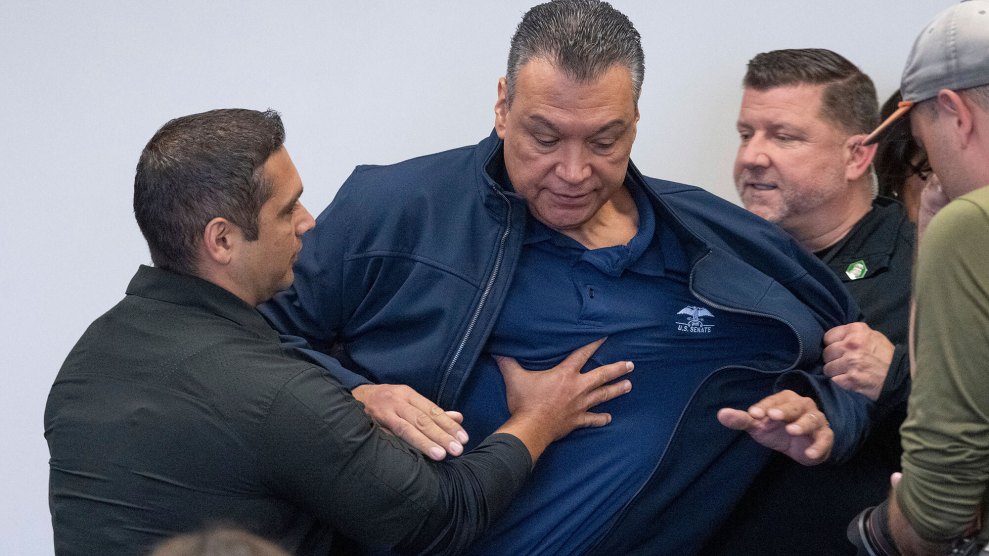
Mother Jones illustration; Getty
Many Republicans are now trying to rewrite the history of January 6 to portray the assault on the Capitol that left five dead as a benign protest. But lawmakers’ fears of extremist violence are reflected clearly in recent campaign filings that show a dramatic surge in spending on security. Among those dishing out the most for protective measures: House and Senate Republicans who have dared to criticize Donald Trump for imperiling our democracy with phony election fraud claims and for inciting his supporters into a bloody rebellion.
Increasingly, Republican and Democratic lawmakers in both chambers—especially those vilified by Trump and his allies—have started hiring security consultants and bodyguards, upgrading their home security systems with cameras, and, in some cases, employing firms that specialize in fortifying residences with reinforced doors, bulletproof glass, and other high-end protective features. An analysis of campaign finance records by Mother Jones found that in the three months after the Capitol attack, security spending jumped 176 percent from the same period last year. Such spending is up 233 percent from the first quarter of 2019.
Prior to the January 6 attack, three-term Rep. Liz Cheney (R-Wyo.) had never spent campaign funds on security. But in the first three months of this year—as she publicly denounced Trump’s role in fueling the insurrection, a transgression for which she was deposed from her leadership post—she paid $58,000 for protective measures, hiring a security consulting firm that specializes in executive protection and retaining three former Secret Service agents who previously served on her father’s vice presidential detail.
While Cheney has continued to speak out against Trump, she said recently that many of her GOP colleagues are too fearful for their safety to risk riling up Trump’s conspiracy-crazed supporters by going against the former president.
“I have had a number of members say to me, we would have voted to impeach, but we were concerned about our security,” she told David Axelrod on an episode of his podcast. “I think that in some ways people have sort of glossed over that, but I think that’s a very important point to pause and contemplate, that you have members of the United States House of Representatives for whom, you know, security—their personal security or their family security, their concerns about that affected the way that they felt they could vote. That’s a really significant thing to say about the current state of our politics.”
Like Cheney, Sen. Pat Toomey (R-Pa.) rebuked Trump for his election fraud lies. After the insurrection, he called on Trump to resign and was one of seven Senate Republicans to vote for Trump’s impeachment in February. The cost of opposing Trump’s bid to overturn the election has been steep: During the first quarter of 2021, his campaign racked up a whopping security tab of nearly $70,000. His campaign’s first payment came on February 8, the day before Trump’s Senate impeachment trial commenced. Among other expenditures, Toomey paid $39,000 to T&M USA, a New York City–based private security and intelligence firm. His campaign filings also list a $7,300 payment to Fortified Estate, a Texas outfit that bills itself as the “leading company for bespoke, high-security hardening of residential and commercial structures” and specializes in installing panic rooms, bulletproof doors, and blast windows.
The campaign operation of Sen. Mitt Romney (R-Utah), who voted to convict Trump during his first and second impeachment trials, paid more than $43,000 to Ambolt Security Group, a Utah-based firm run by former law enforcement officers that offers services including close protection, “safe room consulting and design,” “residential escape plans,” and threat assessments. “Political uncertainty, rioting in US streets, attacks on governance are contributing to a climate of fear within our communities, the business sector, and most troubling our homes and families,” the company notes on its website. (Security is not a subject that members of Congress seem eager to discuss. Mother Jones reached out to 10 lawmakers, including Cheney, Romney, and Toomey. None responded.)
The GOP’s most lavish spenders on security are two of its biggest promoters of the Big Lie. Ted Cruz’s campaign dropped more than $74,000 on a security firm in early 2021, the most of any GOP lawmaker. (In February, when Cruz jetted to Cancun in the wake of a deadly winter storm that left much of his state without power, a reporter dropped by Cruz’s home and found one of the senator’s guards caring for the family rescue dog, Snowflake.) Cruz, who offered to argue a lawsuit seeking to overturn the results of the presidential election before the Supreme Court, first began spending heavily on security in 2020, making payments to a company that installs security cameras and safety glass. Sen. Josh Hawley (R-Mo.), whose memorable raised-fist salute to Trump supporters outside the Capitol on the morning of the attack became an iconic image of that dark day and his role in helping to inspire it, hired security consultants, to the tune of at least $44,000, following the insurrection.
On the other side of the aisle, the two biggest spenders on security are newly elected Sens. Raphael Warnock of Georgia and Mark Kelly of Arizona. Both hail from states that were (and remain) a focus of election fraud conspiracies propagated by Trump and his backers. Warnock, Georgia’s first Black senator, has spent more on security than any Senate candidate in history. Since last fall, his campaign has paid more than $245,000 to Executive Protection Agency, a security service, with $136,000 of that spending coming during the first quarter of 2021. (His fellow Georgia senator Jon Ossoff spent nearly $50,000 on protection between January and April.) The campaign of Arizona’s Kelly—whose wife, former representative Gabby Giffords, was nearly assassinated during a constituent event in 2011—has doled out $130,000 for security so far this year.
Some Democrats—especially high-profile progressives and people of color—have long voiced security concerns. Among them is one of the right’s favorite targets, Rep. Alexandria Ocasio-Cortez (D-N.Y.), who has said she feared for her life during the Capitol insurrection: "I did not know if I was going to make it to the end of that day alive.” AOC’s campaign spent $47,000 on security, including payments to Three Bridges NY, a New York company that provides personal protection to celebrities, between January and April—more than she spent during the entirety of last year. Fellow “squad” member Rep. Cori Bush (D-Mo.), who complained publicly about being harassed by the QAnon-promoting Rep. Marjorie Taylor Greene, paid $35,000 during this period.
In total, congressional campaigns and political parties spent an estimated $2.6 million on security in the first three months of 2021. During the comparable timeframe in 2019, at the start of the last Congress, Federal Election Commission filings show campaigns and political parties made $902,000 in security expenditures. In 2017, parties and campaigns together spent $2 million over the course of the entire year—less than the security costs racked up in the three months after January 6.
Members of Congress who can show they face a genuine threat can request protection from the House or Senate Sergeant-at-Arms offices, but the resources are limited, with only members of congressional leadership receiving full-time security details (Cheney was recently assigned protection by the Capitol Police). Most members of Congress have usually traveled and interacted with their constituents with only a minimal level of security—if any. Their relative accessibility has been one of the features of our congressional system. But the possible threats that lawmakers face were on display in viral videos that circulated this winter showing irate Trump supporters confronting members of Congress including Sens. Romney and Lindsay Graham (who was labeled a “traitor” for mildly rebuking Trump for stoking the insurrection). In footage of the Graham episode, a Trump supporter wearing a QAnon T-shirt declares ominously, “One day they will not be able to walk down the street. It is today.”
The attack on the Capitol has revived an old debate over to what extent political candidates can dip into their campaign coffers to fund security expenses. The FEC has rules preventing the use of campaign funds for personal expenses and has generally applied a strict interpretation of that. For years, it did not allow candidates to spend campaign funds on home security systems and upgrades under the theory that such expenditures would also increase the values of their homes.
But in 2011, following the shooting that severely injured Gabby Giffords, the FEC began to ease its rules when it granted her campaign’s request to use contributions to install a security system at her home. Since then, campaign spending on residential security systems has risen from about $7,100 in 2013 to $143,000 last year. Campaigns have spent $82,000 on security systems in the first three months of 2021 alone.
In 2017, in the wake of the shooting at a congressional softball practice that hospitalized Rep. Steve Scalise (R-La.), then–House Sergeant-at-Arms Paul Irving, citing numerous requests for protection from members of Congress, asked the FEC for more clarification on acceptable security expenses. According to Irving, threats against members of Congress were escalating—in 2016, his office investigated 902 threats. In just the first six months of 2017, it had already looked into 950. Irving testified that his office didn’t have the ability to fully investigate all threats against lawmakers, much less protect them from unknown dangers they might face. More recent numbers suggest the problem has worsened.
In response to Irving's request, the FEC concluded that members of Congress, whether or not they were the target of a threat, could use campaign funds “to pay for the reasonable costs associated with installing (or upgrading) and monitoring a security system at Members’ residences.” The agency issued no further guidance in the years that followed. Then came January 6.
Days after the Capitol siege, the National Republican Senatorial Committee and the National Republican Congressional Committee appealed to the FEC to formally authorize the use of campaign funds for security details—something lawmakers had already started paying for in the absence of any concrete guidance from the commission on the subject.
In late March, the FEC finally ruled that members of Congress “may use campaign funds to pay for bona fide, legitimate, professional personal security personnel to protect themselves and their immediate families due to threats arising from their status as officeholders, when federal agents are not protecting the Members or the Members’ families.”
But that decision sparked a debate of its own. Who did the FEC consider a “legitimate” security professional and what would their roles be? That is, would they protect members of Congress only from threats—or also from potentially uncomfortable encounters with citizens voicing their opinions?
As FEC Commissioner Ellen Weintraub put it during the commission’s hearing in March, “I want to ensure that the people who would be in a position to perhaps block members of the public’s access to their elected leaders would be doing it in a way that is sensitive to the First Amendment concerns.”
Lawyers for the NRSC and the NRCC argued that drawing up language to police the credentials of the guards would slow down the process of getting protection in place for members of Congress who needed it. And the FEC ultimately imposed no strict limitations on who could be paid with campaign funds to perform security. In a brief, the Democratic Senatorial Campaign Committee and the Democratic Congressional Campaign Committee—the NRSC's and the NRCC’s Democratic counterparts—contended that in doing so the FEC was "opening the door to the improper use of campaign funds to compensate fringe militia groups under the guise of legitimate security expense." The groups noted that some Republicans have known links to far-right organizations like the Three Percenters, Proud Boys, and Oath Keepers, whose members participated in the Capitol attack. (In at least one instance, members of the Three Percenters militia group provided security at a campaign event for then-candidate Marjorie Taylor Greene, although they don’t appear to have been paid.) What was stopping Republican lawmakers from employing guards associated with the very same groups involved in the assault on the Capitol?
Nick Steen, a retired Secret Service agent and former supervisor of the agency’s presidential protection division, says it’s clear that members of Congress require more protection. He also notes that it’s not practical to have law enforcement guarding every member of Congress and candidate.
“I don’t know that it is right, cost effective, or efficient to add protection of every congressional or senatorial candidate to the growing list of federal law enforcement responsibilities,” he says. But he adds that leaving security up to the campaigns raises its own set of questions. “If a model for private security is developing for that gap, then a lot of work will need to be done to set parameters and scope for those private security folks. Cost is just one aspect of it,” he says.
The questions of how much security is appropriate and who pays may be coming to a head. In May, the Capitol Police disclosed that already this year its case load had risen 107 percent from 2020 and said it had just 30 officers in its threat assessment division to respond to over 9,000 cases. (By comparison, the Secret Service employs 100 threat assessment staffers who handle 8,000 cases.) Meanwhile, Trump and his allies have stoked conspiracy theories, pinned to quixotic election audits in Arizona and other states, that he could be reinstated to office this summer, concocting a new version of the Big Lie for supporters to rally—and perhaps, plot—around. Rep. Peter Meijer, a first-term Republican from Michigan who voted to impeach Trump and recently decried members of his party for “salivating for civil war,” told Rolling Stone he foresees more political violence ahead: “I don’t put it beyond the realm of assassinations.”


















